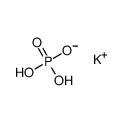
CAS No.: 7778-77-0 Formula: H2KO4P
Weight: 136.085541
Synonyms: Potassiumphosphatemonobasic,anhydrousFCC,≥98.0%(Assay,driedbasis);Potassiumphosphatemonobasic,anhydrousACSreagent,≥99.0%(Titration);PotassiumPhosphate,Monobasic,MolecularBiologyGrade;PotassiumdihyChemicalbookdrogenphosphatecryst.suitableforthebiopharmaceuticalproductionEMPROVEbioPhEur,BP,JPC,NF;Potassiumdihydrogenphosphateanhydrous99.995Suprapur;PHOSPHATESTANDARDSOLUTION;PHOSPHATELOWNO1;PHOSPHATELOWNO2
Potassium dihydrogen phosphate is a kind of highly efficient and rapid dissolving phosphorus and potassium compound fertilizer containing, phosphorus and potassium, two elements for providing the necessary nutrients for plant growth and development, being applicable to any soil and crop, especially being applicable to the treatment of regions of simultaneous lack of phosphorus and potassium nutrients and phosphorus-preferred and potassium-preferred crops. It is mostly used for root top dressing, seed soaking, and seed dressing, being able to yield significant effect. If it sued for the roots fertilization, it can be used as basal fertilizer, seed fertilizer or moderate-late phase topdressing. Its aqueous solution can react with silver nitrate, generating yellow phosphorus dihydrogen phosphate precipitation, being able to be used as a differential reaction. As potassium dihydrogen phosphate is expensive, there is less agricultural production. Therefore, it is generally applied of the soaking or root top dressing for application. For crop soaking, the commonly used concentration is 0.2%. After dipping 18~20h, the field can be sown after drying. For root top dressing, if spraying alone, the highest concentration can be 0.5%. If within the range of jointing-booting stage of wheat and rice, we can spray for 1 or 2 times during the cotton, rape early flowering phase. Upon spraying 2 times, the interval can be about 7 to 10 days with the liquid usage amount per acre being about 100~150kg. It can also be combined with other nutrients to be formulated into compound nutrition for foliage top-dressing. For example, the leaf fertilizer used for field crops in North China has its main ingredient be exactly potassium dihydrogen phosphate, urea and the addition inclusion of some trace elements. In recent years, the use of blade complex nutrition also mostly adopts the potassium dihydrogen phosphate as a high concentration and excellent hydrophilic phosphate and potassium fertilizer source. With the development of facilities of horticultural crops and drip irrigation, fertilizer irrigation, the increasing daily demand for potassium dihydrogen phosphate is also increasing.